
"Japanski filmovi zaokupljeni su okolnostima, onime što okružuje ljudska bića."
Double Suicide (Shinju ten no amijima, 1969)
Review © 2001 Branislav L. Slantchev

| 
|

| 
|

| 
|

| 
|

| 
|

| 
|

| 
|

|  |
http://www.gotterdammerung.org/film/shinoda-masahiro/double-suicide.html
Samurai Spy (Ibun Sarutobi Sasuke, 1965)
Cijeli film:
Assassination (Ansatsu, 1964)
Review © 2007 Branislav L. Slantchev
With the possible exception of Sword of Doom, this has got to be the
most nihilistic Japanese jidai-geki I have seen.
 |
 |
| Ryoma reads Kiyokawa's Wanted Poster | Matsudaira hatching the shogunate's assassination backup |
 |
 |
| Kiyokawa enacting one of the actions of a noble swordsman | The "friendly" duel between Kiyokawa and Sasaki |
 |
 |
| Matsudaira chastises Sasaki for losing to a mere ronin | Tamba Tetsuro as the complicated Kiyokawa |
 |
 |
| Kiyokawa's former students trying to understand him | Running away from the townspeople after the murder |
 |
 |
| Oren getting arrested after the murder | Oren subjected to torture to reveal Kiyokawa's whereabouts |
 |
 |
| The incomparable Iwashita Shima as Oren | Sasaki instructed from Oren's diary |
 |
 |
| Kiyokawa is stuck despite his talents on account of his lowly birth | Oren is Kiyokawa's only refuge and confidant |
 |
 |
| The slaughter at the Teradaya Inn | Ryoma mourning the harm done to others by one whose life is driven by ambition |
 |
 |
| Premier Itakura making sure Kiyokawa will be checked | Kiyokawa and supporters waiting for the Imperial Commission |
 |
 |
| Kiyokawa's grip is paralyzed from the tension | The ignominious end in the back alley |

Himiko (1974)
Opskurna šamanska kraljica Himiko (ili Pimiko) predmet je brojnih
naučnih debata u Japanu, gde je neki istoričari poistovećuju sa caricom
Jingū, koja je bila regent tokom prve polovine III veka nove ere. U
kineskim tekstovima opisana je kao moćna čarobnica, koja uz hiljadu
sluškinja i jednog slugu, posrednika u komunikaciji sa plemstvom i
stranim izaslanicima, obitava u strogo čuvanoj palati. Legende u kojima
je povezuju sa Yamatohime-no-mikoto, kćerkom cara Suinina i osnivačicom
hrama posvećenom boginji Amaterasu, vrlo verovatno su Masahiru Shinodi
poslužile kao glavni izvor inspiracije pri stvaranju mita o poreklu
savremenog japanskog društva.
Predstavljajući Himiko kao lažnu proročicu, jogunastu despoticu i
strastvenu ženu, koju seksualna opsednutost polubratom Takehikom uvlači u
vrtlog ludila i vodi u smrt, reditelj traga za suštinom karaktera svog
naroda i bavi se tesnom povezanošću religije i političkih mahinacija.
Osvrće se na svrgavanje kralja, koji se usudio da posumnja u "reč
božju", potpuni prelazak na matrijarhalno uređenje i oružani sukob
između obožavalaca boga sunca i boga zemlje, izazvan incestoidnom vezom.
Siguran, neometan i brižljiv u smeloj dekonstrukciji prošlosti,
isporučuje nekonvencionalno delo koje balansira između avangardnog
teatra i hotimično izveštačene pseudo-istorijske melodrame. U rešavanju
zagonetke oko Himiko pomaže mu scenaristkinja Taeko Tomioka, sa kojom je
napisao i inventivni Shinjū: Ten no amijima (Dvostruko samoubistvo, 1969) i sa kojom će se udružiti još par puta, na filmovima Sakura no mori no mankai no shita (Ispod procvalih trešanja, 1975) i Yari no gonza (Gonza kopljanik, 1986).
Glavnu ulogu, baš kao i u mnogim ostvarenjima sa njegovim potpisom,
Shinoda poverava svojoj supruzi, Shimi Iwashiti, koja s lakoćom donosi
"šizofreni" lik žrtve ljubavi i okrutne vladarke. Ništa manje značajne
nisu ni glumačke bravure Rentarōa Mikunija (Nashime, Himikoin savetnik),
Masaa Kusakarija (Takehiko) i Rie Yokoyame (zavodljiva sveštenica
Adehiko). Snažan utisak ostavlja i performans trupe Tatsumija Hijikate,
oca butō plesa. Upadljivo našminkani i odeveni poput otpadnika iz neke
alternativne dimenzije, oni se pojavljuju u ključnim trenucima,
premošćavajući emotivne jazove i nagoveštavajući promene zgrčenim
pokretima i bizarnim grimasama.
Minimalistička scenografija, kojom dominiraju geometrijski pravilni
oblici, i jednostavni kostimi čistih boja, lišeni suvišnih detalja,
upućuju na veliku kreativnu slobodu umetničkog direktora Kiyoshija
Awazua. Himiko je moćna bujica velelepnih, a katkad i
uznemirujućih vizuelnih kompozicija, uslikanih kamerom nepogrešivog
Tatsua Suzukija, koji je često sarađivao sa prominentnim avangardistima,
kao što su Toshio Matsumoto i Shūji Terayama.
Nadahnute slike protkane su kakofoničnim skorom muzičkog genija Tōrua
Takemitsua, koji folklorne melodije zemlje izlazećeg sunca preobražava u
prigušene krikove tragedije. Tenzija na relaciji tradicionalno-moderno
kulminira u anahronističkoj završnici, na tragu one iz Jancsovog Szerelmem, Elektra.
Eksperimentalan i hiperstilizovan, ovaj film će sigurno prijati
gledaocima naviknutim na ćefove predstavnika novog talasa, što naravno
ne znači da je ostalima zabranjeno da probaju... - ngbooart.blogspot.com/

Under the Blossoming Cherry Trees
(Sakura no mori no mankai no shita, 1975)
Branislav L. Slantchev
Part ghost-story in the tradition of Kwaidan and part bizarre love-story about a woman ensnaring a less than righteous man in a mode reminiscent of Ugetsu, this film manages to be exquisitely cruel and at the same time strangely alluring, which is not something one normally sees in a thinly veiled sociopolitical commentary. Like Mizoguchi, Shinoda is often interested in the role of women in Japanese society and the place they are supposed to occupy under traditional masculine mores. Unlike the melancholy auteur, however, Shinoda is a lot more ambivalent about the true status of their supposed subjugation by men. In some ways, the supposedly helpless female is the true ruler of what appears to be a man's world. And the fact she exercises that power only indirectly, through manipulating the man's lust for her, does not make it any less real. |  |
| Love at first enchantment | The fateful decision |
 |  |
| I thought I was marrying a manly man | You have to kill them |
 |  |
| I want her for my maid | The pastime of a big city girl |
 |  |
| Monks going mad | Theater of the grotesque |
 |  |
| I need more heads for my party | Extreme casting session |
 |  |
| Morbid sexuality as becomes a ghost | Everything falling apart |
 |  |
| Wherever you go, I go | Back full circle to happier days |
 |  |
| Is she the one? | Under the cherry blossoms |
Shinoda Masahiro
Ever since I saw Double Suicide, Shinoda has been on my get-everything-by-this-guy list. So imagine my delight when Criterion decided to release this film... what turned out to be a truly bizarre entry in the chambara genre. I am still unsure about this film. I think I liked it, but I do not know why. I know why I should not have liked it though. Samurai Spy is really an artsy political intrigue/love story that masquerades as a ninja flick with some reality-defying stunts.
 |  |
| Sasuke always in a fog | A typical stance |
 |  |
| Some gravity-defying leaps | The melancholy dancer Okiwa |
 |  |
| Love and fear in feudal Japan | Meeting Omiyo at the temple |
 |  |
| Sasuke on the long road to nowhere | Still life |
 |  |
| Omiyo barely containing herself | The kidnapping of the orphan girl |
 |  |
| The enemy of my enemy is my friend | More ninja than samurai |
 |  |
| Escape from the Suwa dungeon | Sasuke fights the sinister Takatani |
 |  |
| The blood of a master spy | Gratuitous shot of Yoshimura Jitsuko |
 |  |
| Sasuke out-maneuvered but unbowed | Random shot of Yoshimura Jitsuko |
 |  |
| About to finally cut through the fog | The unseen enemy is the worst |
Bridging the Centuries
Masahiro Shinoda on bringing the classic into modern times
by David Phelps posted November 1, 2011
Unable to conduct an in-person interview with Masahiro Shinoda, halfway across the world, I had about 30 questions of all sorts sent to him via email. I suggested that he could look them over in advance and, once he sat down with a translator, just pick a few that interested him to discuss at length: as a current professor at Wasada University, he could give an impromptu lecture on his own films. Shinoda very generously, and very graciously, sent back via email an audio recording of a completely openhanded 80-minute monologue (with breaks for translation), weaving between a few important points of reference, including a picture-scroll from his own collection, and often responding to multiple questions in single topics and lines. I've left out my original questions, almost all of which were addressed, and which are now implicit in the responses.
I'm extremely grateful not only to Mr. Shinoda, but to his interpreter, Okura Yoshiko, and especially to Ishida Satoko, my Shochiku intermediary who not only arranged the interview, negotiated the details, and translated and communicated my written correspondence to Mr. Shinoda's office, but also has been extremely helpful at every step in assisting me with information and materials. —DP
Masahiro Shinoda: As you know, the original script for the film [Shinju ten no amijima (Double Suicide, 1969, adapted from Chikamatsu] comes from ningyo joruri [puppet theater, or Bunraku], and has been staged and played many times in many forms by people—and puppets. But in my research, I found that the scripts used for production were, in fact, rewritten many times and had lost their original sources. And in a way, for us to accurately restore the classicism of the original material of the 17th century was a way for us to rediscover the art of the 17th century in our own time. This was an idea I had developed from the 1950s, from before I was a filmmaker, but since I'd become a director I had always wanted to do this: to show the original Chikamatsu as it was written, not the versions that had been revised to suit more musical versions of the production over the many hundred years.
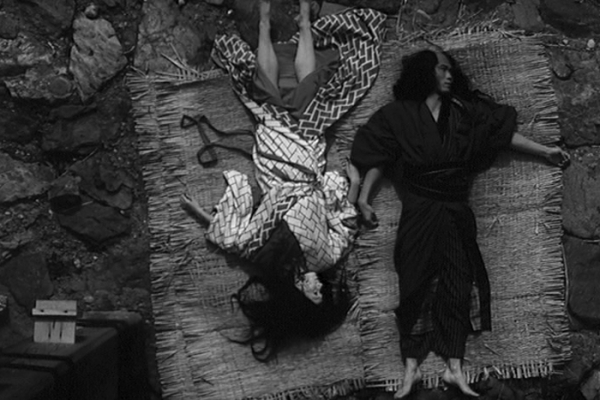
As a result of this, my film became very theatrical, as an expression, because obviously we did not have the budget to use big sets, outdoor sets, and to build them, and we obviously did not have the technology, CGI, that would enable us to recreate the period, like we can do now. As Oshima and Yoshida, I believe, did, we were working in a limited space directing actors in a very symbolic way.
In the 1960s in Europe, there was a conceptual movement called the Black Theater. The idea was to find ways to put on a play without any art, without any production design or devices, to recreate the quintessential world of pure theater only by use of words. And I had heard about this, and in Japan, I had actually seen a stage play take on a similar sort of challenge. Around this time, I had also come upon Toru Takemitsu's radio play of Shinju ten no amijima, and because it was over the radio, the sounds I was hearing, the voices, seemed like they were coming from this place of darkness: they almost had an operatic power, a hold, a resonance. The film I had wanted and Takemitsu's radio drama: there was something there. And like the fatal aspect of the story, and because there was a realism I wanted to have in the film, it was something I couldn't run from. But as I said, I only had a limited budget for my expressions. So I couldn't build huge houses, or a red light district, for this film. I decided to use kuroko stagehands as my intermediaries.
Now in ningyo joruri, the kuroko, the ones in black, are of course the ones who manipulate the dolls. But in my film these dolls were going to be played by actors. So when it comes to film, you actually see people who are playing the kuroko, who are also manipulating, or pushing along, the stories and the characters within the film. But I wanted these elements to come together in the form of cinema, not theater, so I came up with the concept that the hands, the fingers, of the kuroko are in fact those of Chikamatsu's, the author's intention. He was very ambitious, and I saw this as him being ambitious enough to dominate even the destinies of the characters in his play, so in fact when you see the kuroko's hands, those are the hands of Chikamatsu's intentions, those of the unseen god, those of destiny. And I thought by materializing this to be seen, the audience would be able to see the author's, or the filmmaker's, or the artist's intention. So just by watching the film with this device, you would not only get the fictional drama being created, but the intention of the filmmaker, of the artist: why this drama was created, why the characters were moved this way. And the audience would be able to see all this. This is definitely something that can only be done in the territory of film. And again, to explain it again, I basically took away the rule in puppet theater that the kuroko must not be recognized as any force within the fictional world. And by taking that away, I thought the audience would be able to confront the author, or the filmmaker, or the artist themselves.
The prologue of the film was such a hard thing to overcome in the making of this film. I discerned the roles of the kuroko in the puppet theater, and I took them out, and I made them gradually guide the actors, and that became the introduction of the film. And I was also going to lay the opening credits over this sequence, so we decided to have music scored for this scene. But in fact on the day of, we didn't have the music yet, and it was Takemitsu who told me to call the screenwriter Tomioka Taeko and to recreate our discussion about the last scene over the phone—and to record that and use it for the music of the scene. So this particular music was in fact the screenwriter and the director with their imaginations in exchange, and this whole idea was in fact not mine, but Mr. Takemitsu's. This kind of spontaneity was something I experienced throughout the making of the film, and in all sorts of different sections and stages. Some of it came from proposals from the actors, and the crew, and some were very surprising, and so for the entirety of the film I had no storyboard at all. And every scene I took with one take—and David, I know you had a question about the montage sequences in my earlier films, but here I attempted to do long takes, as long as Mizoguchi's.
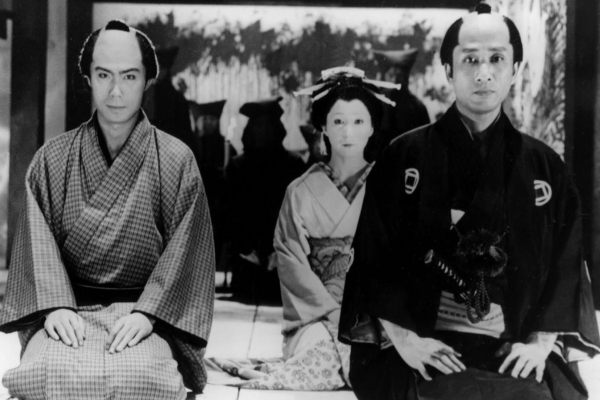
Mishima had committed suicide in 1970. What my peers, Oshima and Yoshida, were experiencing, I hope you can discern from their work. For me personally this was the climax of the prosperity that Japan had experienced. And this was of course partly due to the fact that we were occupied by a big, strong country like America, and this was the conclusion that we as a society, a country, were coming to, that Japanese culture had become localized. There were not many people at the time who could even read Shinju ten no amijima in its Chinese characters. And I felt I had seen this landscape of a culture deteriorating; many skyscrapers were being erected in the city at the time. When you would go out, the sense of life as something optimistic was overwhelming. The Japanese identity, for me, though, of the time, seemed to be disappearing.
And this was the feeling that was very prevalent in me even when I directed Pale Flower. We were on the brink of a new era, of IT, high technology—and committing shinju for love in the 17th century was in fact something that happened in Osaka in reaction to what were, perhaps, the first displays of capitalism in Japan. And within me I felt that this was maybe a foreshadowing of what would happen to our own capitalism as a country, that this was the capitalism we would have to face in the future. And so the tragedy that the independent small business merchants suffer in this film was the tragedy that I felt that we were about to, or would eventually have to face in Japan.
Now you have a question about why I pursue beauty, but that I wanted to make my films as elegies to those who fail and collapse was something I already recognized within me at this point. This was quite intentional when I chose the theme of shinju here, because my intention as an artist was to strike outside of the confines of society, to become an outsider—to put it in beautiful language—to become a filmmaker and do my work there. And this was before I was 40, but to become an outsider, to make a film there, was probably something I wouldn't have been able to accomplish if there had been a studio producer looking over my back.
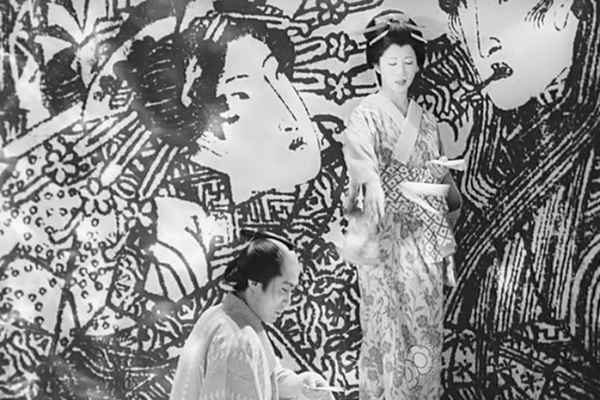
Looking back in hindsight, Mishima had written an essay about how in theory we would have to defend our country by means of culture if by law we were not able to use force anymore. And as he wrote these essays, I saw these samurai swords, which in the end he used to kill himself, were being replaced by golf clubs.
From ancient times to the middle ages in Japan, the Japanese as a race would often use decapitation in battles and wars.
[Here Shinoda pulls out a book with a print, from Go Sannen Kassen Emaki, a picture scroll from 1087 that unfortunately can't be included here due to rights issues. Along with a riding warrior and a tree, the emaki depicts three racks of decapitated heads, a few fallen on the ground, as if hung like modern laundry.]
The backstory of this picture is an Auschwitz of a kind, in that particular headhunters from the Northeastern part of Japan had risen to strike against the establishment, where they were countered by a force that surrounded the capital. And they were all killed, and their heads were left to be exposed.
In ningyo joruri, the doll, or puppet, is called the kashira, which also means "head" in Japanese, so the expressions of each of the kashira becomes of course the main theme and story of the production. This ningyo joruri came about around the same time that Noh had come into the Japanese history of entertainment. Noh of course is a stage play where masks are used in a similar manner to the kashira (dolls).
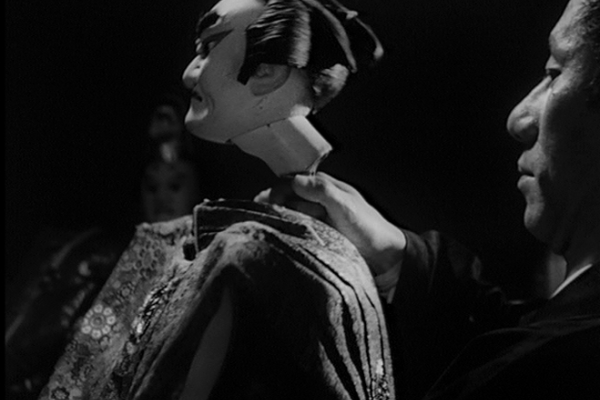
In contemporary Japan since 1945, the Japanese people have not killed anybody—not one person—through the act of war. It might be the only country that has managed to do this. At the same time, every year we see more than 30,000 people kill themselves, while traffic accidents, which were born out of motorization in modernity, have gone down to 10,000 a year.
There's this feeling that you are inadequate or unable to show your true colors in your work, in your company that you work for, in your family that you look after, or in your society, to the extent of taking your own life. The act of dying in war that's always been celebrated, because in a way you're doing it for your country, is no longer there: these suicides are probably a new Japanese experience that show how repressed we are in contemporary times.
Occasions and opportunities to help you enjoy your life, like Christmas sales, all sorts of discounts, Disneyland, have been imported into Japan. But on a personal level, these Americanisms are impossible for me to feel optimistic about. And I am unable to find beauty in the death of these 30,000 people who were suicides. For me, this has to do with the idea of how to die beautifully. And it is because of this beauty that I find myself interested not only in people who actually go to the lengths of dying, but those who are on the way to death, or being corrupted, or failing and falling apart. The victors are always arrogant. But losers lose with a great amount of imagination. And I think that in this sense, the losers are closer to cinema's own possibilities of imagination.
In Shinju ten no amijima, my wife and actress Shima Iwashita played two roles, and of course the reason isn't because I didn't have the budget to get two actors for the role, but because my perception of women is that of woman as a prostitute and woman as a wife: and essentially, I believe, this is the same thing. Now in the Western world, you would take an actor and talk about their characteristics, say you take the two Hepburns, Katherine and Audrey, and say that they're different. But for me, they're both Hepburns [laughs]. For men, it's nice to have a woman in the prostitute mold and a more loyal wife—and while you can go to whichever you like, for a man to be close or drawn to a woman requires Eros. If you were looking at a woman and trying to choose, or show her in the light of morality or that of Eros, I would feel very uncomfortable having to choose the former as a standard to use to talk about, or describe, or portray her. And this is because I have a mother complex: my mother for me is the eternal woman. My mother was very wise as a person, and I have great respect for any woman who is able to bring up a child: women by nature are gifted with the ability to have children, which I fundamentally have great respect for, while men, on the other hand, for me are only objects I can fight. Now in Shinju ten no amijima, my wife played Oharu, who of course is a prostitute and figure of Eros, and Osan, who's a more domesticated wife character, and I think these two are the motivations for men to love a woman: and this is the only thing I'm interested in in this subject.
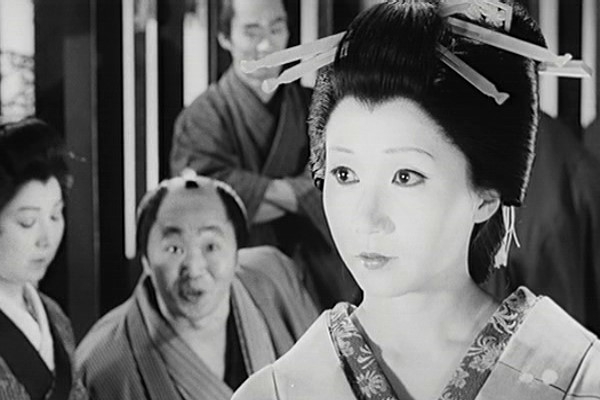
In any case, I feel more strongly that I've been given blood by my mother than my father, and I think this sense has to do with Japan being an island country, where fathers can move around freely, but mothers have to stay very close to home. And I think because of this, our country is traditionally very much a matriarchy. Now thinking about that and looking at cinema, which was born in the 20th century in France and went to America and became this huge industry, America's of course a country that sought independence from England, and the idea can be seen in—or has strong ties to—American westerns and genre films.
But when you look at Japanese cinema, though, I don't feel that it started in the 20th century, because, say, you take a film like Ugetsu, by Mizoguchi, there's a beautiful woman, in this case played by Machiko Kyo, who lures a man and turns out to be an evil spirit. When we look at the motifs of the film, the story actually harks back to the middle ages in Japan, and that has very much to do with the history of theater in Japan. And in this sense I feel that Japanese cinema and the history of it is very different from that of world cinema, and this is also something you'll be able to discern from Kurosawa's Seven Samurai.
Now the younger filmmakers in Japan that are making so-called J-horror films are the successors of the Ugetsu tradition, if you will. And in The Seven Samurai, the character played by Mifune, the local farmer dreaming of becoming a samurai, is very much the Taro-Kaja character that's seen in Kyogen in the art of Noh. Now when they made their films, Kurosawa and Mizoguchi, perhaps unconsciously within that postwar environment, had to lean on Japanese tradition, because they knew that they weren't Americans. And so their films had a sense of Japanese tradition, but my films I approach more from a rational than mystical point of view, based on my own very real confrontation with a postwar society. And that's where I come from as a filmmaker.
My views and perceptions of women, or feminism, come from my mother, as I was telling you. But when it comes to my father, I felt that I could study him: a father is more of a social being that is linked to the more political fate of a nation. And the mother, by contrast, is an eternal sort of lifeblood that symbolizes it. And I think directors like Oshima and Yoshida were trying to create films from a more rational, patriarchal approach to their filmmaking, whereas I was probably trying to make films from a more motherly approach, where sometimes things would not be able to be explained only rationally. We have the term Japanese New Wave, but you can't brand us by one label.
Now as you know, I have retired and announced my retirement from filmmaking. And I am researching currently the junction between Japanese entertainment and contemporary times, and the relationship between these two, which I'm very drawn to. My current book attempts to break down theater through anthropological and historical points of view. But this particular field is barren, it's a wasteland. I still hear the sounds of the camera rolling, the voices you hear on the set, and the crew and myself running around: that vision, that space, is something that hasn't disappeared inside me yet. It is almost as if I had pulled the brakes on a locomotive while the train is still moving, and now it's riding on the rail. And whether the engine will be started again on this living train, and whether I will return from the barren wastelands of the academics to the more civilized world of film, remains to be seen.
And this is my answer to you, David, whom I haven't had the pleasure of knowing yet.
I'm extremely grateful not only to Mr. Shinoda, but to his interpreter, Okura Yoshiko, and especially to Ishida Satoko, my Shochiku intermediary who not only arranged the interview, negotiated the details, and translated and communicated my written correspondence to Mr. Shinoda's office, but also has been extremely helpful at every step in assisting me with information and materials. —DP
Masahiro Shinoda: As you know, the original script for the film [Shinju ten no amijima (Double Suicide, 1969, adapted from Chikamatsu] comes from ningyo joruri [puppet theater, or Bunraku], and has been staged and played many times in many forms by people—and puppets. But in my research, I found that the scripts used for production were, in fact, rewritten many times and had lost their original sources. And in a way, for us to accurately restore the classicism of the original material of the 17th century was a way for us to rediscover the art of the 17th century in our own time. This was an idea I had developed from the 1950s, from before I was a filmmaker, but since I'd become a director I had always wanted to do this: to show the original Chikamatsu as it was written, not the versions that had been revised to suit more musical versions of the production over the many hundred years.

Double Suicide
But despite my idea, this was material that definitely wasn't suited for mass consumption. The mass audience for a film at the time had no interest in this type of material, especially set in the Edo era—and Kabuki and film by this time were very different mediums of art. And there were no producers willing to take on the project either. I had been, as you know, at Shochiku studios, which are also producers of Kabuki, and where Ozu, of course, had worked. And I myself, like Oshima, had become independent from Shochiku, in order to make my own films for the audience, especially for the intellectuals among the public. The motivation was, why not make films for the intellectuals? And so I found myself in a situation where we had a dramatically low budget, but a dramatic freedom to make films, and this was the beginning of ATG, the Art Theater Guild. We found ourselves able to choose what we wanted to make, without the financiers' meddling. And this situation was really very much a miracle. But again the budget we were able to work with was dramatically low.As a result of this, my film became very theatrical, as an expression, because obviously we did not have the budget to use big sets, outdoor sets, and to build them, and we obviously did not have the technology, CGI, that would enable us to recreate the period, like we can do now. As Oshima and Yoshida, I believe, did, we were working in a limited space directing actors in a very symbolic way.
In the 1960s in Europe, there was a conceptual movement called the Black Theater. The idea was to find ways to put on a play without any art, without any production design or devices, to recreate the quintessential world of pure theater only by use of words. And I had heard about this, and in Japan, I had actually seen a stage play take on a similar sort of challenge. Around this time, I had also come upon Toru Takemitsu's radio play of Shinju ten no amijima, and because it was over the radio, the sounds I was hearing, the voices, seemed like they were coming from this place of darkness: they almost had an operatic power, a hold, a resonance. The film I had wanted and Takemitsu's radio drama: there was something there. And like the fatal aspect of the story, and because there was a realism I wanted to have in the film, it was something I couldn't run from. But as I said, I only had a limited budget for my expressions. So I couldn't build huge houses, or a red light district, for this film. I decided to use kuroko stagehands as my intermediaries.
Now in ningyo joruri, the kuroko, the ones in black, are of course the ones who manipulate the dolls. But in my film these dolls were going to be played by actors. So when it comes to film, you actually see people who are playing the kuroko, who are also manipulating, or pushing along, the stories and the characters within the film. But I wanted these elements to come together in the form of cinema, not theater, so I came up with the concept that the hands, the fingers, of the kuroko are in fact those of Chikamatsu's, the author's intention. He was very ambitious, and I saw this as him being ambitious enough to dominate even the destinies of the characters in his play, so in fact when you see the kuroko's hands, those are the hands of Chikamatsu's intentions, those of the unseen god, those of destiny. And I thought by materializing this to be seen, the audience would be able to see the author's, or the filmmaker's, or the artist's intention. So just by watching the film with this device, you would not only get the fictional drama being created, but the intention of the filmmaker, of the artist: why this drama was created, why the characters were moved this way. And the audience would be able to see all this. This is definitely something that can only be done in the territory of film. And again, to explain it again, I basically took away the rule in puppet theater that the kuroko must not be recognized as any force within the fictional world. And by taking that away, I thought the audience would be able to confront the author, or the filmmaker, or the artist themselves.
The prologue of the film was such a hard thing to overcome in the making of this film. I discerned the roles of the kuroko in the puppet theater, and I took them out, and I made them gradually guide the actors, and that became the introduction of the film. And I was also going to lay the opening credits over this sequence, so we decided to have music scored for this scene. But in fact on the day of, we didn't have the music yet, and it was Takemitsu who told me to call the screenwriter Tomioka Taeko and to recreate our discussion about the last scene over the phone—and to record that and use it for the music of the scene. So this particular music was in fact the screenwriter and the director with their imaginations in exchange, and this whole idea was in fact not mine, but Mr. Takemitsu's. This kind of spontaneity was something I experienced throughout the making of the film, and in all sorts of different sections and stages. Some of it came from proposals from the actors, and the crew, and some were very surprising, and so for the entirety of the film I had no storyboard at all. And every scene I took with one take—and David, I know you had a question about the montage sequences in my earlier films, but here I attempted to do long takes, as long as Mizoguchi's.

Double Suicide
Because we, the artists, auteurs living in the 20th century, were going to tell the story of a love affair taking place in the 17th century in Osaka, and because we were not just approaching the play, but approaching it through the author, Chikamatsu, and approaching it through his inner landscape, I feel the way we were able to bring the classic into modern times was itself a trip, and one that left very different tracks from the normal way you would recreate a classic for contemporary times. Now in terms of music, Takemitsu completely denied the use of any kind of instrumental music that would traditionally be used in Kabuki or a puppet play, and his main keynote was to be the gamelan music from the Indonesian island of Bari, and also the pipes and flutes and drums of Turkey. And the effect, toward the end of the film, as they press down on the story, and attenuate the story, is completely the opposite kind of music than that of a Kabuki production.Mishima had committed suicide in 1970. What my peers, Oshima and Yoshida, were experiencing, I hope you can discern from their work. For me personally this was the climax of the prosperity that Japan had experienced. And this was of course partly due to the fact that we were occupied by a big, strong country like America, and this was the conclusion that we as a society, a country, were coming to, that Japanese culture had become localized. There were not many people at the time who could even read Shinju ten no amijima in its Chinese characters. And I felt I had seen this landscape of a culture deteriorating; many skyscrapers were being erected in the city at the time. When you would go out, the sense of life as something optimistic was overwhelming. The Japanese identity, for me, though, of the time, seemed to be disappearing.
And this was the feeling that was very prevalent in me even when I directed Pale Flower. We were on the brink of a new era, of IT, high technology—and committing shinju for love in the 17th century was in fact something that happened in Osaka in reaction to what were, perhaps, the first displays of capitalism in Japan. And within me I felt that this was maybe a foreshadowing of what would happen to our own capitalism as a country, that this was the capitalism we would have to face in the future. And so the tragedy that the independent small business merchants suffer in this film was the tragedy that I felt that we were about to, or would eventually have to face in Japan.
Now you have a question about why I pursue beauty, but that I wanted to make my films as elegies to those who fail and collapse was something I already recognized within me at this point. This was quite intentional when I chose the theme of shinju here, because my intention as an artist was to strike outside of the confines of society, to become an outsider—to put it in beautiful language—to become a filmmaker and do my work there. And this was before I was 40, but to become an outsider, to make a film there, was probably something I wouldn't have been able to accomplish if there had been a studio producer looking over my back.

Shima Iwashita in Double Suicide
Yari no gonza [Gonza the Spearman, 1986; Shinoda's second Chikamatsu adaptation] again is a film that takes place in the Edo era, when the shogunate is established, when the Bushi soldiers are no longer able to use their source of livelihood, their swords. And this was also an allegory of the time when the film was made, because in our constitution, we had to abandon all forms of self-defense as a country. Now the Japanese love golf. And the golf clubs are there to replace the swords that the Bushi warriors would carry.Looking back in hindsight, Mishima had written an essay about how in theory we would have to defend our country by means of culture if by law we were not able to use force anymore. And as he wrote these essays, I saw these samurai swords, which in the end he used to kill himself, were being replaced by golf clubs.
From ancient times to the middle ages in Japan, the Japanese as a race would often use decapitation in battles and wars.
[Here Shinoda pulls out a book with a print, from Go Sannen Kassen Emaki, a picture scroll from 1087 that unfortunately can't be included here due to rights issues. Along with a riding warrior and a tree, the emaki depicts three racks of decapitated heads, a few fallen on the ground, as if hung like modern laundry.]
The backstory of this picture is an Auschwitz of a kind, in that particular headhunters from the Northeastern part of Japan had risen to strike against the establishment, where they were countered by a force that surrounded the capital. And they were all killed, and their heads were left to be exposed.
In ningyo joruri, the doll, or puppet, is called the kashira, which also means "head" in Japanese, so the expressions of each of the kashira becomes of course the main theme and story of the production. This ningyo joruri came about around the same time that Noh had come into the Japanese history of entertainment. Noh of course is a stage play where masks are used in a similar manner to the kashira (dolls).

Double Suicide
Now I am, of course, aware of many decapitation stories in other cultures, those associated with the guillotine in the French revolution, Marie Antoinette and so forth. In Japan, though, even apart from the many political instances where warriors were beheaded, there were many stories also of soldiers or samurais decapitating their children's heads to cover for their master's child, or for their master. By the arrival of the Meiji era, Japan had stopped their tradition of decapitation, but within the traditional Japanese theater, we still see this tradition continued in the form of use of kashira and the masks. And I feel hara-kiri is very closely connected to beheadings as well. Because in loyalty through death, or virtue through self-sacrifice, within this act, I feel the Japanese concept that mortality's an illusion.In contemporary Japan since 1945, the Japanese people have not killed anybody—not one person—through the act of war. It might be the only country that has managed to do this. At the same time, every year we see more than 30,000 people kill themselves, while traffic accidents, which were born out of motorization in modernity, have gone down to 10,000 a year.
There's this feeling that you are inadequate or unable to show your true colors in your work, in your company that you work for, in your family that you look after, or in your society, to the extent of taking your own life. The act of dying in war that's always been celebrated, because in a way you're doing it for your country, is no longer there: these suicides are probably a new Japanese experience that show how repressed we are in contemporary times.
Occasions and opportunities to help you enjoy your life, like Christmas sales, all sorts of discounts, Disneyland, have been imported into Japan. But on a personal level, these Americanisms are impossible for me to feel optimistic about. And I am unable to find beauty in the death of these 30,000 people who were suicides. For me, this has to do with the idea of how to die beautifully. And it is because of this beauty that I find myself interested not only in people who actually go to the lengths of dying, but those who are on the way to death, or being corrupted, or failing and falling apart. The victors are always arrogant. But losers lose with a great amount of imagination. And I think that in this sense, the losers are closer to cinema's own possibilities of imagination.
In Shinju ten no amijima, my wife and actress Shima Iwashita played two roles, and of course the reason isn't because I didn't have the budget to get two actors for the role, but because my perception of women is that of woman as a prostitute and woman as a wife: and essentially, I believe, this is the same thing. Now in the Western world, you would take an actor and talk about their characteristics, say you take the two Hepburns, Katherine and Audrey, and say that they're different. But for me, they're both Hepburns [laughs]. For men, it's nice to have a woman in the prostitute mold and a more loyal wife—and while you can go to whichever you like, for a man to be close or drawn to a woman requires Eros. If you were looking at a woman and trying to choose, or show her in the light of morality or that of Eros, I would feel very uncomfortable having to choose the former as a standard to use to talk about, or describe, or portray her. And this is because I have a mother complex: my mother for me is the eternal woman. My mother was very wise as a person, and I have great respect for any woman who is able to bring up a child: women by nature are gifted with the ability to have children, which I fundamentally have great respect for, while men, on the other hand, for me are only objects I can fight. Now in Shinju ten no amijima, my wife played Oharu, who of course is a prostitute and figure of Eros, and Osan, who's a more domesticated wife character, and I think these two are the motivations for men to love a woman: and this is the only thing I'm interested in in this subject.

Shima Iwashita in Double Suicide
I lost my mother at the age of 22, and the loss was so great that I almost doubted the existence of the world around me. I recently, as you well know, have written a book and have received a Kiyoka Izumi award for it: a book I wrote on the history of Japanese theater. Interestingly Izumi also lost his mother, at the tender age of nine: his mother's name was Suzu, which in Japanese is the sound of the bell ringing. Later when he got married, his wife had also by law the same name, Suzu, and was a geisha. Of course his work was the basis for my film Demon Pond, by which time I had revisited his works for the film, and had discovered that in childhood he went through the same emotional experiences I went through, in losing our mothers, and I think the ghost of Izumi is what shone a light onto my book that led to this award. By now, you probably think I'm quite into mysticism, but that's not quite true.In any case, I feel more strongly that I've been given blood by my mother than my father, and I think this sense has to do with Japan being an island country, where fathers can move around freely, but mothers have to stay very close to home. And I think because of this, our country is traditionally very much a matriarchy. Now thinking about that and looking at cinema, which was born in the 20th century in France and went to America and became this huge industry, America's of course a country that sought independence from England, and the idea can be seen in—or has strong ties to—American westerns and genre films.
But when you look at Japanese cinema, though, I don't feel that it started in the 20th century, because, say, you take a film like Ugetsu, by Mizoguchi, there's a beautiful woman, in this case played by Machiko Kyo, who lures a man and turns out to be an evil spirit. When we look at the motifs of the film, the story actually harks back to the middle ages in Japan, and that has very much to do with the history of theater in Japan. And in this sense I feel that Japanese cinema and the history of it is very different from that of world cinema, and this is also something you'll be able to discern from Kurosawa's Seven Samurai.
Now the younger filmmakers in Japan that are making so-called J-horror films are the successors of the Ugetsu tradition, if you will. And in The Seven Samurai, the character played by Mifune, the local farmer dreaming of becoming a samurai, is very much the Taro-Kaja character that's seen in Kyogen in the art of Noh. Now when they made their films, Kurosawa and Mizoguchi, perhaps unconsciously within that postwar environment, had to lean on Japanese tradition, because they knew that they weren't Americans. And so their films had a sense of Japanese tradition, but my films I approach more from a rational than mystical point of view, based on my own very real confrontation with a postwar society. And that's where I come from as a filmmaker.
My views and perceptions of women, or feminism, come from my mother, as I was telling you. But when it comes to my father, I felt that I could study him: a father is more of a social being that is linked to the more political fate of a nation. And the mother, by contrast, is an eternal sort of lifeblood that symbolizes it. And I think directors like Oshima and Yoshida were trying to create films from a more rational, patriarchal approach to their filmmaking, whereas I was probably trying to make films from a more motherly approach, where sometimes things would not be able to be explained only rationally. We have the term Japanese New Wave, but you can't brand us by one label.
Now as you know, I have retired and announced my retirement from filmmaking. And I am researching currently the junction between Japanese entertainment and contemporary times, and the relationship between these two, which I'm very drawn to. My current book attempts to break down theater through anthropological and historical points of view. But this particular field is barren, it's a wasteland. I still hear the sounds of the camera rolling, the voices you hear on the set, and the crew and myself running around: that vision, that space, is something that hasn't disappeared inside me yet. It is almost as if I had pulled the brakes on a locomotive while the train is still moving, and now it's riding on the rail. And whether the engine will be started again on this living train, and whether I will return from the barren wastelands of the academics to the more civilized world of film, remains to be seen.
And this is my answer to you, David, whom I haven't had the pleasure of knowing yet.
The Closed World: The Films of Shinoda Masahiro – Surface play and subterfuge in the movies of a modern classicist
“If we abandon the gods, what must take
their place in order to support the center of the culture?… It is
difficult to decide what will take the place of the gods. I have never
believed that culture is something one can ‘make.’”
“I must categorize the films of the world
into three distinct types. European films are based upon human
psychology, American films upon action and the struggles of human
beings, and Japanese films upon circumstance. Japanese films are interested in what surrounds the human being. This is their basic subject.” — Shinoda Masahiro
 I. Way In
I. Way InCircumstance is a subject, but unlike personal psychology or the struggle for individualism, it doesn’t offer a particular perspective: just the material for one. “Never as radical as Oshima, nor as consistent as Yoshida, and certainly never as satirical as Imamura, Shinoda, on the other hand, is unquestionably the most versatile of the New Wave directors,” offers David Desser in his book Eros Plus Massacre, even if versatility, a salaryman’s virtue, is not quite a viewpoint. “[I am] not interested in utopian ideals,” Shinoda has said, more simply. “I would like to be able to take hold of the past and make it stand still so that I can examine it from different angles.” Per Desser, Shinoda’s “most significant authorial characteristic, the comparison between traditionalism and modernism (in terms of both social norms and aesthetic practice)” is only a playing of worldviews against each other.
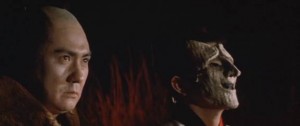 Dealt
with films in all colors, shapes, and settings, and unable to discern
an auteurist imprint beyond a hodgepodge of motifs—historical backdrops
at moments of transition; occasional theatricality; street
processionals; a nihilistic critique of Japanese imperialism—American
critics, sensing that “in pure visual and sound experience his films
impress with lush flamboyance,” have logically posited the means as an
end. “The director’s main concern,” says Donald Richie, is “an
exclusively aesthetic one—namely, the shape of men’s lives, the patterns
they make.” “His contribution to the generation of the 1960s has been
his devotion to beauty,” Audie Bock ends her profile on him. “Surface
rather than substance,” writes Carole Cavanagh.
Dealt
with films in all colors, shapes, and settings, and unable to discern
an auteurist imprint beyond a hodgepodge of motifs—historical backdrops
at moments of transition; occasional theatricality; street
processionals; a nihilistic critique of Japanese imperialism—American
critics, sensing that “in pure visual and sound experience his films
impress with lush flamboyance,” have logically posited the means as an
end. “The director’s main concern,” says Donald Richie, is “an
exclusively aesthetic one—namely, the shape of men’s lives, the patterns
they make.” “His contribution to the generation of the 1960s has been
his devotion to beauty,” Audie Bock ends her profile on him. “Surface
rather than substance,” writes Carole Cavanagh.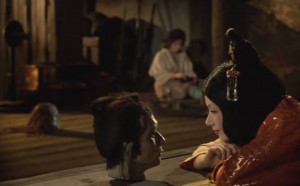
From his early, sun tribe JD films (’60-’62) to yakuza and samurai pieces (’64-’65) to chamber dramas, Brechtian theater and deconstructed myth (the late ’60s to the ’70s), and even in his late, naturalist histories (‘80s-’02), Shinoda’s films offer a pictorial beauty that its own excuse, an art for art’s sake that’s almost always positioned politically even so. The open question remains whether Shinoda’s picturesque sense of environs and choreographic sense of movement are the product or antithesis of a soulless landscape: an art reacting against social realities, or just the extension of social role-playing?
***
No way in, no way out: Shinoda’s story is almost invariably of an
outside agent, often a girl, who rebels against power politics either
through some abstract, aesthetic ideal—at least six of his films follow
artists or musicians, and even the equivocating samurai in Assassination
only finds respite in a ballad—or in a viral attack on the system,
whether an authoritarian kingdom or household. “The Japanese have a
belief that it is purer to sacrifice themselves for things invisible
than to do so for a political cause.”But in either case, the agent turns out an unwitting victim of circumstance whose only expression is in the violence of a local, historical politics that can’t be transcended. Shinoda has described both Pale Flower, his yakuza reappraisal, and Samurai Spy, his Samurai reappraisal, as reflections of the cold war: a solitary hero, the Japanese idealist in a cultural wasteland, becomes the pawn of opposing powers whose politics are a mask for power. Almost every Shinoda of the period has this set-up of a rebel whose only expression of identity is in picking between equal superpowers. According to Desser, already in Dry Lake, Shinoda’s first film, “Shinoda claims that he and [screenwriter] Terayama confronted the fact that whereas the rightists in Japan typically resorted to terror and violence (as in the assassination of JSP leader Asanuma), the emerging left was similarly becoming so inclined.” “Power will never perish,” says Lord Mizuno in Buraikan—“it will always be replaced by another.”
In Shinoda’s films, the characters whose dedication to “style” gives the films their own, lose something like personal expression—whether a sense of morality, feeling, or the mundane—to mask-like roles and inherited ideals. These films mine a voguish existentialism, even “nihilism” (Shinoda’s term), in stories of rebels who infiltrate closed worlds by submitting to their choreography of violence, their external morality of men and women who are only as good as their their sword-fights, their car races, their rockabilly hip thrusts. The classic beauties turn nihilistic as styles that are their own end: Shinoda gets surface tension from characters, like the camera, seemingly oblivious to anything but their own movements.
In the 60s films, scenes of slaughter, flight, and cunnilingus are abstracted by slow-motion and a biwa’s accompaniment into visual motifs: an appeal to the eye instead of body in a slow crescendo of repeated thrusts forward. But the realization that the most visceral, physical moments of Shinoda’s ’60s films are abstracted into unfurling lines of motion offers only one angle. Another is that these distantiation techniques only make the scene more immediate, more visceral: the viewer projects himself into the scene by rhythm alone. These moments seem to compound traditional Japanese virtues of aesthetic disinterestedness (iki) all at once with a 60s rejection of classical geometries, with Antonioni fog, and with the invisible hand of Toru Takemitsu, the modernist composer who used natural rhythms as ostinato, and insisted directors pare down their soundtracks for the maximal inflection of single sounds. “I will make the film. That’s one voice. Takemitsu is another voice,” says Shinoda, the director Takemitsu worked with most. “I wanted these two voices to come together.” (1)
In Shinoda’s ’60s works, the sounds of the scene become the rhythms of the film.
Takemitsu’s music is generally used to dramatize only the least dramatic moments. The duels in Samurai Spy (available from Criterion), a film in which a distant zoom happens upon the key action, are usually accompanied by bird calls that sometimes change pitch and species at crucial junctures. The teen rock-and-roller of Tears on a Lion’s Mane, fantasizing a fame perpendicular to his world of class conflict, walks down busy streets to the sounds only of his footsteps. In Punishment Island, face offs are counterpointed by the slide-whistle of the wind and the breaking sea, Shinoda’s favorite sound, while shots of the sea are silent or accompanied by Takemitsu’s warbling strings. An undertaker’s hammering is the film-long beat and meter in Buraikan. And in Pale Flower, yakuza gambling scenes, set like business meetings around an empty grave with only the movements of hands, cards, and Shinoda’s swiveling montage, the pure exteriority of men in ritual is matched by echoing castanets and tap: the rhythms of dance in the ceremonies of an echo chamber.
However pure that beauty, there’s always some awareness of its expense. “Circumstance,” a historical reality beyond the studio’s purview, already grates against aesthetics in Shinoda’s early, pop-JD films like Killers on Parade (1961), a windshield view onto a contemporary Yokohama of brutalist architecture and primary-colored yakuza who sing a cappella and are finally wiped out as a gang leader, dripping red paint, hopscotches his last steps to the sounds of real waves and an imitation train whistle. Yet in Shinoda the movie’s splay of seemingly arbitrary movements become part of a schema of effects: matching tracking shots and pans that build an almost classical rhythm of refrain and response. In the opening jump cuts, as the yakuza line up in a clear movie studio to shoot an apple off a girl’s head, miss, and splatter the wall in paint, Shinoda, as Godard would a few years later, flaunts violence for a surface beauty on film that only comes at the expense of any real-world index-point.
That beauty is the painted face of violence will be the more obvious target of recurring, iconographic posters that give mobsters and militants the cover of societal legitimacy throughout Shinoda’s ’60s films: Hitler in Dry Lake, JFK in Killers on Parade, the Mona Lisa in Pale Flower, Abraham Lincoln in Punishment Island, Marilyn Monroe in Petrified Forest. “Culture is nothing but the expression of violence,” Shinoda has said, adding, “also, human tenderness is unthinkable without violence.”
Violence is an art form, but art is unthinkable without violence: is that aestheticism or its critique? All of Shinoda’s films seem to teeter between material interpretations of violence at beauty’s root through Japan’s history, and Shinoda’s own abstraction of violence into something beautiful. Art of circumstance or circumstances of art? Circumstance is a web of arts in Shinoda: by 1964 an extended sword fight in Assassination (available on Masters of Cinema) is shot with a gliding tracking shot, almost absent of sound, in the attenuated motions of Kabuki. As late as Owl’s Castle (1999), the athletes’ rehearsals for battle and Kabuki are nearly the same; Buraikan (1970) follows a failed Kabuki actor (Tatsuya Nakadai) who becomes an unwitting revolutionary instead. It was in Kabuki that Shinoda “found that violence is at the root of all human passion, the fundamental enthusiasm of the human being.”
Art and politics again: Shinoda has repeated that his nihilism comes from his desire to kill himself at 15 at the emperor’s surrender of god status, and the ongoing search and failure since then to find anything on earth worth dying for, even while the formal illusions and hierarchies of culture—everyday and aesthetic—have had to be maintained. “I wanted to know, ‘Where are our gods? Have they gone?’… The origin of drama started in a religious form, trying to communicate with God especially in the Noh and Kabuki theater. The main theme is to bring death into the world.” And: “In my films, I have tried to show the present through the past and history, coming around to the truth that all Japanese culture flows from imperialism and the emperor system. What characterizes Japan is the imposition upon the people of absolute power and authority without the right to question and debate… I find, however, that politics leads to nothing, and that power politics remain empty.”
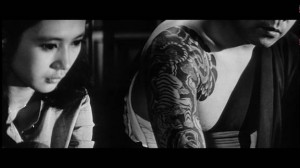

Buraikan (1970)
Buraikan (1970), Shinoda’s comedy about underground Kabuki
actors who stage an underground rebellion on a soundstage 1840s, gives
Shinoda’s most easily distilled thesis that men are dolls, God withdraws
as a source of meaning and leaves materialism to rule itself. Even
self-sacrifice seems less defiant than inevitable. Unlike Mishima’s
beautiful suicide in Patriotism, or the classically Japanese,
tragic martyrdoms in Kobayashi, one of Shinoda’s favorite directors,
resignation is rarely noble in Shinoda: the traditional coupling of ninjo (personal feeling) and giri
(social obligation) seems to become a duel between self-destructive
urges, lust, and material gain at one end, and an absurd, historically
determined system of oppressive morality and debts on the other. In both
men are puppets to their own lives. beautiful and hollow, and, as in
the traditional Japanese fables Shinoda would adapt, led on by the
superficial beauty of enchantresses: both Shinoda’s leading ladies, Kaga
Mariko and his wife, Iwashita Shima, have a doll’s cat-eyes and glutted
lips behind which may lie anything or nothing. But these dolls are
never quite allegories for experience: in Shinoda, allegory seems
impossible in a world in which meaning is localized, historically
determined, and life is lived not only for but as the external grace of good pupeteering. When the endings of Silence (available on Masters of Cinema) and McArthur’s Children
call for allegories of Christ and politics—a priest projects himself
into the role of Christ as a martyr for humanity; a baseball match
between America and Japan pits brute modernity against hangdog
tradition—Shinoda sheds larger statements for local concerns: the priest
is not Christ and will help his tortured brethren better in apostasy
and submission to the state; a dog grabs the ball and the game ties. In Buraikan,
a revolutionary sets fireworks in defiance of Mizuno, who responds that
there can’t be fireworks, he outlawed them; in the outskirts of town a
matriarch marvels: “how beautiful!”
With Beauty and Sadness
Two compass points for Shinoda, Oshima and Kobayashi, posit in very
different ways a struggle of the personal against the political, one
that collapses as the two become mirrored reflections: the victim of the
state turns victimizer, while violence, as in Shinoda, is the fulcrum
of both expression and suppression. But where Kobayashi’s films
schematize a clear pattern of disillusionment, an impossible ninjo against an inescapable giri, Shinoda’s show illusion, however beautiful, on all sides: personal desire becomes self-interest within the context of a time.And where Oshima’s films seem framed by an irreducible metaphysic of guilt, sadism, and alienated subjectivity, all affirmed in the battle against them, Shinoda’s movies see these things as historical vectors rather than inescapable worldviews. Spy Sorge opens with a quote by the Chinese writer Lu Hsun: “Hope cannot be said to exist, nor can it be said not to exist. It is just like roads across the earth. For actually the earth had no roads to begin with, but when many men pass one way, a road is made.” But even in this message of hope, there’s no way out.
***
Childhood Days (1990)
Asked how to avoid sentimentality in late, character-based histories like MacArthur’s Children,
Shinoda has said to play character interests against each other—again a
balancing of views—but added: “What I most wanted to do with this film
was to shoot the school ground. And I wanted to do it from the vantage
point of the corridor that connects the classrooms. After receiving your
training in the classroom, you come out and feel the wind or the rain
in that corridor.” Padded by sentimental coming-of-age stories and
viscid melodies, these late films have drama in background detail and
historical setting: the anecdotal Children climaxes around the
point when a girl needs to pee in a ’40s straw outhouse, and asks a boy
to sing a traditional Japanese anthem so he won’t hear. But at the same
time Shinoda’s approach to history as a stage for classical narrative
was being developed by directors as different as Pialat, Yang, and Hou,
in films in which history is inscribed even in the gestures of how one
hangs around.
The Petrified Forest (1973)
Shinoda’s ’70s films, often accompanied by oneiric Takamatsu scores, are more expansively realized. The Petrified Forest
charts culture clash in mundane detail while insanity spreads as a
disease; in the historical films, characters move through the static
frame and stop to watch street processionals without realizing they’re
part of the passing crowds as well. The Ballad of Orin, perhaps Shinoda’s culminating work, tracks a traveling goze, blind singer Iwashita, through 70 locations, all four seasons, and a series of exploitations recalling Mizoguchi’s The Life of Oharu except that, without the onus of a transcendental martyrdom, the goze
has a sex drive as well. Her lover is not the love of her life but one
more important than the rest, and even her sacrifice to him, repeating Silence,
is to an ideal, invisible love. At the dawn of industrialization and
militarization, the blind leading the blind are matched with marching
soldiers, and what starts as fable ends in a particular time and place.
The Ballad of Orin (1977)
But it’s Shinoda’s ’60s films that hew closest in form to life as the
art of circumstance. Using every abstraction the Japanese New Wave had
taken against convention—freeze-frames, overhead shots, 180-degree cuts,
handheld CinemaScope, and high-contrast smears of white scene detail
against preponderate blacks at night—Shinoda arranges them in films like
Tears on the Lion’s Mane, Pale Flower, Samurai Spy, Assassination, and Punishment Island into a coherent syntax of matching tracks, scene bridges, and symmetrical openings and closings.As with his slow-motion abstractions to music, Shinoda gets his dynamism in these movies from a concatenation of alternating angles, speeds, and motions. One pattern is to start with a hero’s close-up, then pivot centrifugally around him through 90-degree cuts till the camera has full scope of the scene and can circle on its own: the character becomes the scene’s central axis. But the technique slows and hardens in the late ‘60s: a five-minute circling pas de deux in With Beauty and Sadness, a seven-minute stage at the showdown of Punishment Island, a three-minute, deep-focused poison preparation in Petrified Forest. Still the characters, never points of access into the scene, are staked in the center of rooms like ornamental pillars. Except for Double Suicide, there are relatively few point of view shots in Shinoda: where classic Hollywood grammar works its way through a scene from the inside-out, through characters’ viewpoints onto it, Shinoda, like many of his peers, works from the outside-in so that the characters are set up as one object among many in a composition. The effect of near-silent montages, frequent in Samurai Spy, is usually of characters gliding in a weightless world and propelled by their own momentum. In the debates of Assassination, the characters playing out their political roles seem to become abstractions of themselves.
II. Way Out
A Man Vanishes (Imamura, ’67), Double Suicide
The exception that could prove a rule is Double Suicide,
Shinoda’s 1969 adaptation of a Chikamatsu play that begins as a
backstage documentary as both Shinoda and the hooded stagehands, kuroko,
talk on the phone. Shinoda, on the location he’s found for the
graveyard finale: “But it captures the space on stage, the nothingness, a
sort of fetishism of space, the vivid contrast between that and the
bodies of the couple… the essential image needs to be captured.”A thesis to decode the meaning and intent of Shinoda’s formal conceits seems unavoidable in a film that shows set changes, Iwashita playing double role of courtesan and wife, and ancient lovers performing their duty in suicide alongside kuroko performing their own duties on-stage to assist the killings, and off, answering the phone. The puppets, critics have said, are symbols of “Shinoda’s sense of the powerlessness of ordinary men,”(2), the stagehands symbols of the artist meting fates out at will, the Brechtian approach the marker of a stringent social conscience. “The emphasis on the artificiality of the drama serves the purpose of distancing the audience in a Brechtian fashion. The audience cannot identify with the individual characters, and is therefore forced to observe, much the same way as the kurago [sic].” (3) The whole thing is symbols, from the calligraphy on the walls to Iwashita’s double performances, each coded in traditional make-up. “Shinoda is commenting upon the significance of roles and signs in society. Cast in the role of courtesan, Iwashita becomes eroticized; cast in the role of wife, Iwashita becomes de-eroticized… And the very conventions that make Koharu an object of desire and Osan an index of obligation are the ones that inevitably drive Jihei to suicide.” (4) “The strain of tensions between the boundedness of the puppet play—the confines of the genre—and the limitlessness of cinema are immediately apparent.” (5) Or did Shinoda say that it’s cinema that frames the empty void of the stage to give it, almost arbitrarily, subject, context, and meaning—a fetishistic form?
If Double Suicide, a ningyo joruri (puppet play) adaptation, were demonstrating that men live as puppets—victims of circumstance in their theatrical formalities—it would, as Desser says of Shinoda’s Demon Pond, only be institutionalizing old conventions as new ones. Shinoda’s explosion of puppet plays would be a puppet play, its code of meaning inescapable. And this is very nearly what happens a couple years earlier in Imamura’s documentary A Man Vanishes: as the characters over tea discuss the nature of truth, as elusive to the documentarian as the vanished man, Imamura has his stagehands disassemble their room as he announces that “nobody knows the truth… this is a stage set, but you all talked as though it was really a cozy room. The set took on the life of a real room… This is fiction.” The moment is as much an attack on the manipulations of the subjects and filmmaker as their complicity with the audience: reality is simply the stage on which truth is manufactured.
By 1969 in Japan, more attempts at taking to the streets seem to end in halls of mirrors. Imamura’s trick-reveal, simultaneous to the French New Wave’s collusions between reality and fiction, ends with a line, “the film is finished, but reality is not,” matching Jean Rouch’s at the end of The Human Pyramid that “it’s not what happened within the film that mattered, just what happened outside of the film… the film ends, but life goes on.” But where Imamura indicts daily life as a set, Rouch sees a stage for revolution. By 1969, some Japanese directors seem to be trying for this theater of revolt as well in mock-documentaries: Hani Susumu’s Inferno of Love (’68), Terayama Shûji’s Throw Away Your Books, Rally in the Streets (’71), Yoshida Kiju’s Eros Plus Massacre (’69), and Oshima Nagisa’s The Man Who Left His Will on Film (’70) all concern filmmakers who may be inventing and projecting themselves into the world on-screen as a political act of revolution. (6) Or, alternately, may be trapped like Imamura’s ruffled subjects in their own subjective perceptions. Or objective habits. Or, alternately, may not be able to project themselves into their world of revolution at all except by—in more than one of those films—playing the projector light over their naked bodies.
In the Oshima, in particular, the mysteriously dull footage of houses from a dead man is unsatisfactory to the communist cell that watches it both because its intentions are illegible and because intentions, wherever they are, are necessarily subjective, and thus inadmissible to communal spirit: the footage belongs neither to the realm of subjective intentionality nor familiar, objective fact, but as unprocessed material in-between, and though the communists are attempting to overthrow both personal subjectivity and societal objectivity, they struggle to find either intention or indexicality in the film to make sense of it. Each needs the other. The footage needs some fundamental truth-value, as in Imamura or Rouch, in order to become meaningful as a contextualized stage, with props and a premise, for fiction and a revolution.
In some way these are also the questions of Double Suicide, a film severed from both subjective intentionality—the film is a staging and weaving of cultural traditions beyond any individual worldview—and any notion of objective realism—the closed world of ritual and ceremony that, as usual in Shinoda, men create and are created by. Are the actors and filmmakers witnesses or agents on-screen? Whose life is led when truth is a communal manufacture? Where is the worldview, and in 1969, the world?
The answer of Chikamatsu’s paper merchant to sophomoric questions of obligatory conventions is to flee from one lover to the other, while defaulting on his debt—however emotional, invariably expressed in economic terms—to whatever woman he’s just left. As Carole Cavanagh points out, paper, “on which the source text is calligraphed, and… on which all the private promises and legal contracts binding the characters together are written… draws together story, design, cinematic construction, and theme.” The merchant’s worldly ties are in paper, though as Cavanagh goes on, it is the contractual bond between the merchant’s two women—the wife asking the courtesan not to lead her husband to double suicide—that provides the “humanizing” touch. But this ostensible liberation and act of understanding is also what dooms the characters to more economic debts, as the wife tries to repay the courtesan by buying her freedom, and to the final suicides of the lovers, each alone. Even suicide is worldly: a symbol of money repaid, and thus a social currency. Every attempt of the characters to take agency of their life results in subjugation to it: they’re all passive witnesses. And when the merchant, like the revolutionary in Eros Plus Massacre, tries to knock down the shoji—paper walls—he only reveals the larger stage.
In an inversion of A Man Vanishes, in which the stage is fake the but the filmmaking reality, here the merchant’s rooms are the movie’s only reality to believe in against an artificial studio. Unlike his contemporaries, Shinoda doesn’t stage a fictional documentary but a documentary of a fiction. In Double Suicide, Shinoda’s opening discussion about a tentative ending is neither the voice of an original authorial figure nor a faithful interpreter of Chikamatsu subjected to the dictates of the play, any more than the kuroko, whose faces are visible under the hoods as they sing like a Greek chorus, are shorthand symbols for the heavy hands of fate, nor, exactly, victims of the play’s demands. As Shinoda looks for bodies that will serve as presences over an absent space, his own role, like that of the kuroko, becomes one of a living performer playing his part willingly, and in the present tense, within the film’s discourse of documentary footage, long takes and diegetic realism, against the abstraction of the sets, the two-dimensional compositions, the traditional Kabuki acting. Not just a naturalist qualification to Kabuki, he’s also an elemental cog in a vast, material puppet machine: like so many Shinoda characters, a tool of his own actions.
The scaffolding of Double Suicide, then, certainly isn’t so simple as puppeteer and puppet, author and player, fate and victim, intention and sign, or even giri and its actors, the courtesans to social custom. It also isn’t so simple as ninjo vs. giri, since in the film’s complete exteriority, ninjo, personal desire, is already bound up with giri: personal desire, again, can only be expressed economically, and the concern of the play is not how a man and his mistress can run off together, but how they can do so within (not against) both their (financial) bonds to the people around them. Nor is the space even as simple as a predetermined staging of a predetermined plot of predetermined social conventions that Shinoda has undermined by placing such formalities over an indeterminate blank void: that would still be a thesis, a supposedly “Brechtian” revelation that there is no basis for their roles, that there is no origin for their strings, and that their “fated” actions are of their own, material devising in an empty world to which they’ve given arbitrary limits. Even that would imply some measure of potential intentionality on the part of the main characters, and they have none: the acting is traditionally declamatory, coded, and seen only though the sympathetic gazes of the kuroko watching a spectacle. Both the set and the kuroko are totally devoted not only to deconstructing the play as play, but to making it as beautiful as possible.
Instead, the tentative space of Double Suicide is one of inscription, the pure exteriority of signs: one of paper sets covered in words and pictures, sets in which characters can write their own histories on papers, but only in the worldly language of economic terms, and can only act as signs, so that Iwashita’s wife is coded by her blackened teeth, a traditional Kabuki make-up. Yet against the void, blank canvas of the graveyard, this writing of bodies on the ground, bodies seen and heard breathing and mostly watched walking, are some sign of material life that recalls Artaud: “The actors with their costumes constitute veritable living, moving hieroglyphs,” for whom words and signs are valued not for what they signify, but “for their shape and their sensuous emanations.” The bodies, performing specific, gestural variations on coded movements, become analogous to the calligraphy on the set’s walls that has a phonetic, meaningless meaning only at certain alignments, but is always expressive as an artist’s abstraction: frequently the writing on the walls breaks down to lines and curves and ink blots in which the original letter is hardly discernible. Similarly the characters, initially so coded, and even because of such codes, become almost pure, performing bodies without a pretense of interiority: as in dance, the differences between the character and the actor collapse in a costumed body no longer signifying anything but itself moving on-set. They are signs floating free from any meaning but their own action, beauty.
Double Suicide is not only a documentary of its impossibility as a documentary, but a real, beautiful documentary of bodies moving in rhythm across spaces: the film it’s closest to might be Michael Powell’s Bluebeard’s Castle. Radical and traditional, its self-reflexive stagings are both another ’69 anti-establishment exposure of a manufactured landscape as well as a sort of foundational myth. The lovers die alone at the hands of the dutiful kuroko, but a final, handheld overhead shot restores them both to their ideal, eternal companionship as well as to the opening, handheld sequence, and thus the outermost layer of the text and set: Japan, 1969, where a kuroko answers the phone and dead lovers on the ground give a nearly standard image of the time—climaxing films from Eros Plus Massacre to Poem to Go Go Second Time Virgin. Projected onto some eternal present that’s as much 1720 as 1969, the lovers are still just agents of their times.
Endnotes
- Shinoda interview, disc feature on Samurai Spy Criterion Collection DVD.

- Joan Mellen, program notes for Shinoda retro at MoMA in mid-1970s.

- Claire Johnston, Criterion DVD notes. Reprinted from Focus on Film #2, March/April 1970.

- David Desser, Eros Plus Massacre: An Introduction to the Japanese New Wave Cinema, Bloomington: Indiana University Press, p. 177.

- Nina Cornyetz, “Scripting the Scopic: Disinterest in Double Suicide,” in The Ethics of Aesthetics in Japanese Cinema and Literature: Polygraphic Desire, London: Routledge, 2007.

- Desser provides a more sustained comparison of three of these films in his final chapter of Eros Plus Massacre.

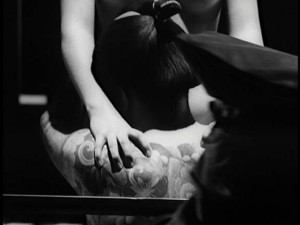
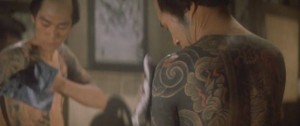
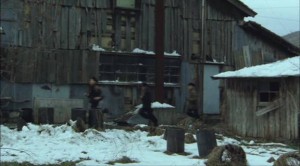
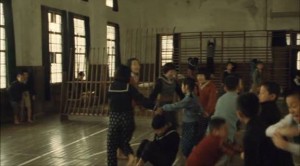
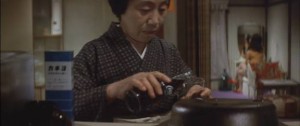
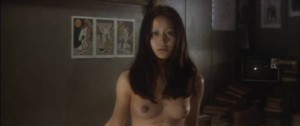
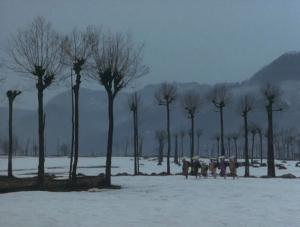

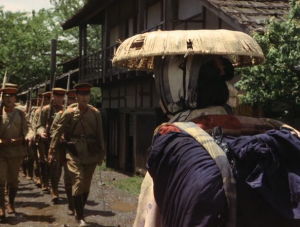
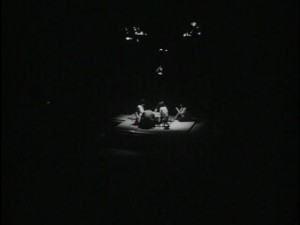
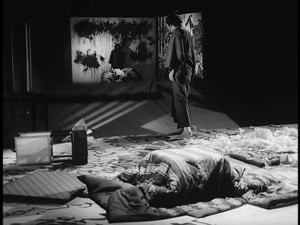
Nema komentara:
Objavi komentar